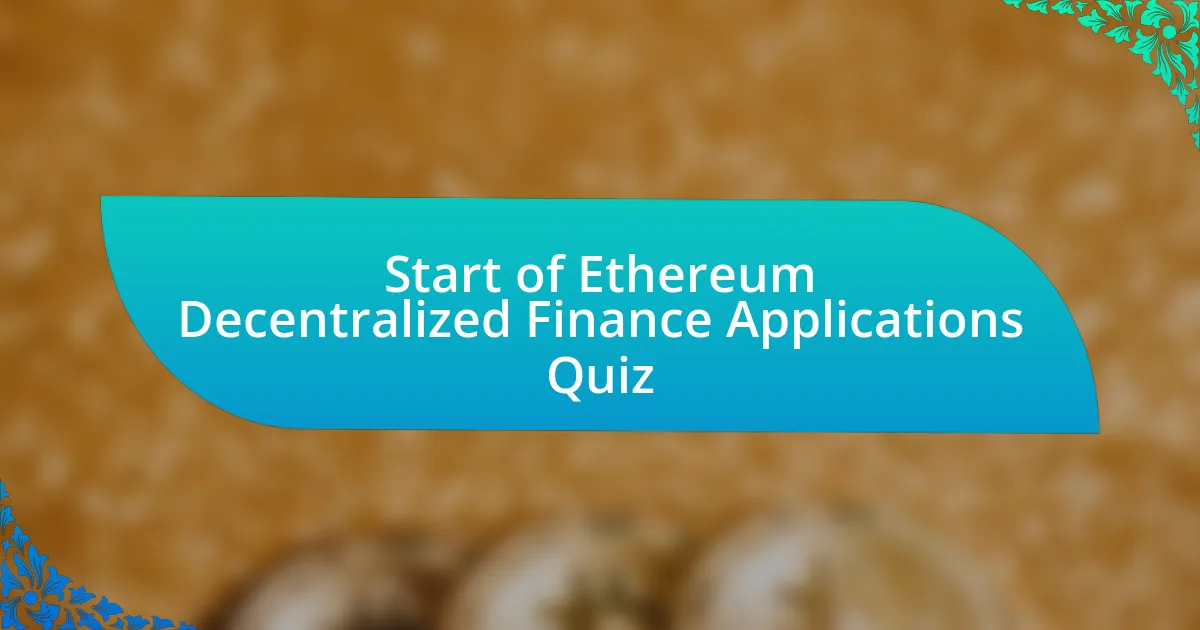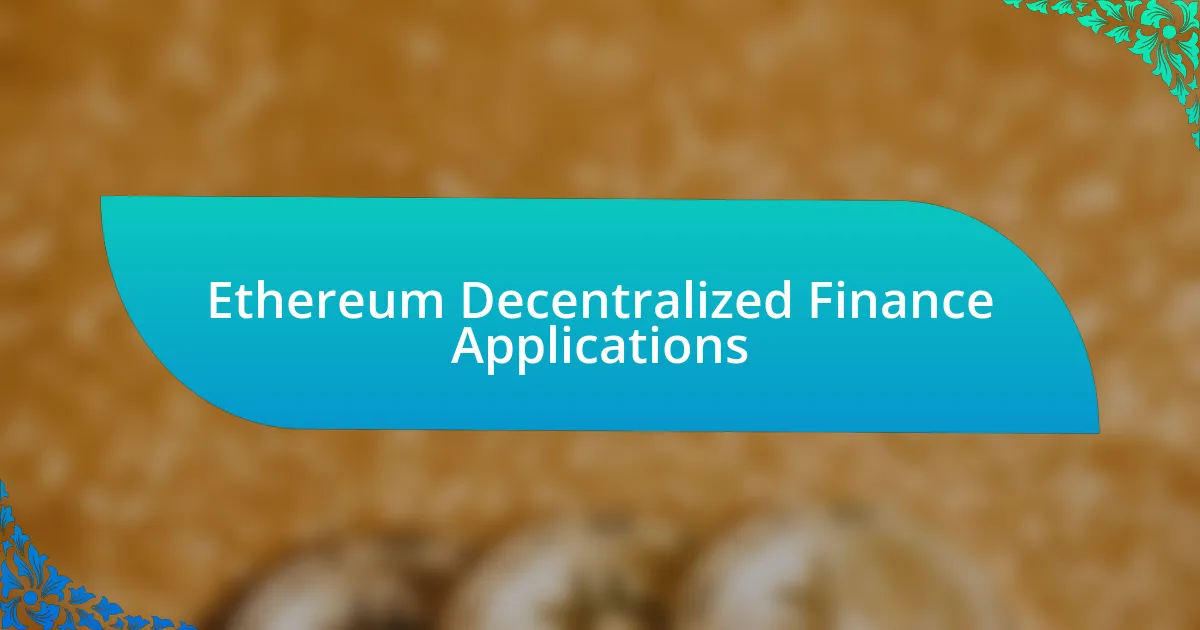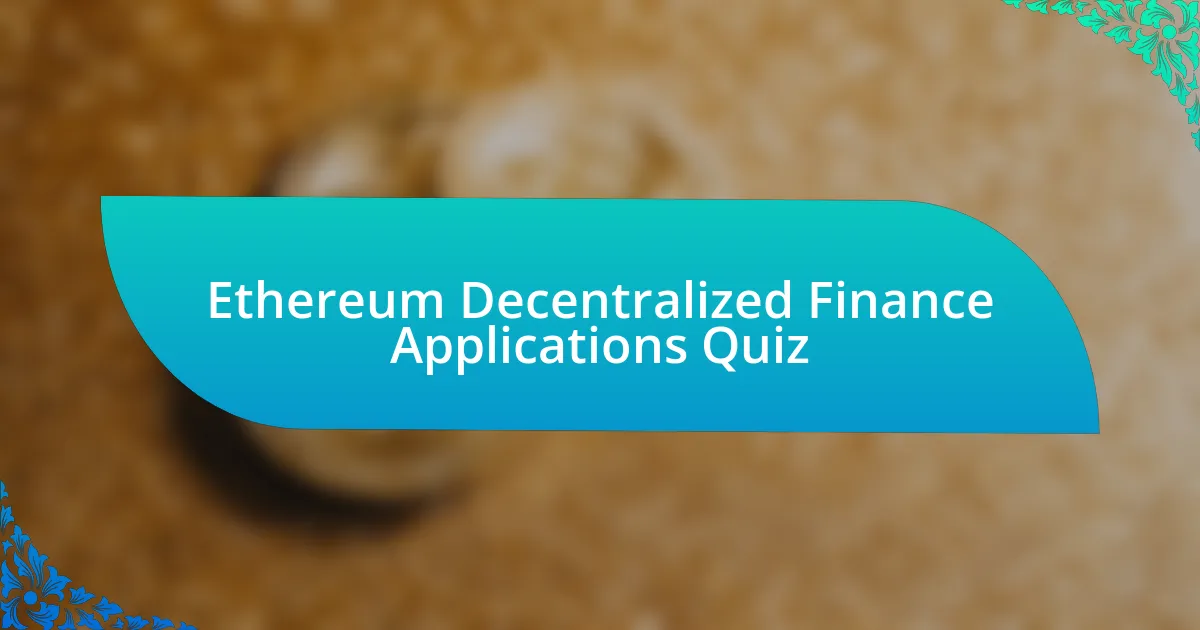
Start of Ethereum Decentralized Finance Applications Quiz
1. What is the primary purpose of Ethereum?
- To limit blockchain usage to transactions only.
- To create a centralized banking system.
- To enable smart contracts and decentralized applications.
- To serve as a digital currency alternative.
2. How is Ether used within the Ethereum network?
- Ether is primarily a voting mechanism for network governance on Ethereum.
- Ether serves as a fixed interest-bearing asset within Ethereum`s ecosystem.
- Ether is used to pay for transaction fees and computational services on the Ethereum network.
- Ether acts as a digital currency for offline purchases in Ethereum.
3. What consensus algorithm is Ethereum transitioning to as of the Merge?
- Proof of Stake
- Delegated Proof of Stake
- Practical Byzantine Fault Tolerance
- Proof of Work
4. What allows Ethereum to support more complex applications compared to Bitcoin?
- Centralized nodes
- Smart contracts
- Proof of Work
- Limited transactions
5. Why are dApps considered decentralized?
- dApps require a single authority to function.
- dApps operate on blockchain, reducing central control.
- dApps utilize local servers to manage data.
- dApps are only available through specific software.
6. What platform records transactions on Ethereum?
- Blockchain
- Ledger
- Database
- Platform
7. Can you name the three types of Ethereum networks?
- Mainnet
- Offchain
- Crosschain
- Sidechain
8. What tools are necessary for mining Ethers?
- Geth CLI
- Eclipse IDE
- Visual Studio
- PyCharm IDE
9. How can smart contracts be applied in real estate transactions?
- Smart contracts can replace real estate agents for all transactions.
- Smart contracts can automate property transfers upon payment completion.
- Smart contracts can only be used for buying furniture online.
- Smart contracts can record land property on paper documents.
10. Which browser extension acts as a wallet for Ethereum?
- EtherKeeper
- ChainSaver
- CryptoWallet
- MetaMask
11. What is the main programming language for writing Ethereum smart contracts?
- C++
- JavaScript
- Python
- Solidity
12. What is the role of Truffle in Ethereum development?
- Truffle is a cryptocurrency exchange platform.
- Truffle is a consensus algorithm for Ethereum.
- Truffle is an Ethereum blockchain explorer.
- Truffle is a testing and development environment for Ethereum.
13. What is the average block time in the Ethereum network?
- 10 seconds
- 14 seconds
- 30 seconds
- 60 seconds
14. Are Ethereum transactions publicly viewable?
- No, only large transactions are viewable.
- Yes, but only for certain users.
- Yes, all transactions are publicly viewable.
- No, transactions are private and hidden.
15. What key is used by users to sign their transactions on Ethereum?
- Public Key
- Private Key
- Transaction Hash
- Seed Phrase
16. What is the purpose of checking the latest state in Ethereum?
- To verify account balances
- To estimate block times
- To track transaction fees
- To validate smart contracts
17. What happens to a transaction if it runs out of gas before completion?
- All state changes are reversed, and the used Ethereum Gas is given to the miner.
- The transaction is held in a pending state until more gas is supplied.
- The transaction completes successfully, and no fees are returned.
- The transaction fails, but all gas fees are refunded to the sender.
18. How does the nonce field in a transaction enhance security?
- The nonce field prevents replay attacks.
- The nonce field speeds up transaction processing.
- The nonce field encrypts private keys.
- The nonce field hides transaction amounts.
19. What is the outcome of dividing -5 by 2 in Solidity?
- 2
- -2
- -3
- 3
20. What distinguishes an Ethereum address from a public key?
- A public key is 20 bytes long.
- A public key is 32 bytes long.
- An address is 20 bytes long.
- An address is 64 bytes long.
21. What is the denomination hierarchy in Ethereum from smallest to largest?
- Ether, Szabo, Gwei, Wei
- Wei, Gwei, Szabo, Ether
- Wei, Finney, Gwei, Ether
- Gwei, Szabo, Finney, Ether
22. How does a DeFi protocol operate on Ethereum?
- A DeFi protocol relies on traditional banks to facilitate its operations.
- A DeFi protocol requires centralized authorities to process transactions manually.
- A DeFi protocol operates using smart contracts to automate financial transactions.
- A DeFi protocol operates only on private networks with restricted access.
23. What functions does the Compound protocol serve?
- Compound is a decentralized exchange for NFT trading.
- Compound is a trading protocol for crypto derivatives.
- Compound is a staking platform for yield farming on Ethereum.
- Compound is a lending protocol allowing users to borrow and lend DAI, ETH, WBTC, and other tokens.
24. What is DAI and who creates it?
- Binance issues DAI, a centralized digital asset.
- Bitcoin creates DAI, a volatile cryptocurrency.
- Ripple manages DAI, a regulated fiat currency.
- MakerDAO generates DAI, a decentralized stablecoin.
25. What functionality does 1inch provide as a DEX aggregator?
- 1inch only facilitates token staking without trading options.
- 1inch is a centralized exchange for buying crypto directly.
- 1inch functions exclusively as a lending protocol.
- 1inch is a DEX aggregator powering flexible swaps and trades through their native protocol.
26. What layer does Velodrome operate on?
- Optimism
- Ethereum
- Binance
- Solana
27. What type of platform is GMX?
- traditional financial marketplace
- blockchain storage solution
- decentralized exchange platform
- centralized transaction network
28. What services does Matcha offer to users?
- Matcha provides online courses for cryptocurrency trading.
- Matcha is a DEX aggregator offering swaps and limit orders for 6+ million tokens across 9 networks.
- Matcha is a decentralized governance platform for NFTs.
- Matcha is a social media platform for trading advice.
29. How does Marinade Finance benefit SOL token holders?
- Marinade Finance allows SOL holders to earn passive yield through liquid staking.
- Marinade Finance solely facilitates the exchange of SOL for USDT.
- Marinade Finance is a marketplace for buying and selling SOL tokens.
- Marinade Finance is designed to store SOL tokens securely without earning yield.
30. What unique feature does Origin Dollar provide to users?
- Origin Dollar provides a unique physical card for spending crypto.
- Origin Dollar allows for anonymous transactions without a wallet.
- Origin Dollar is the first stablecoin to earn a yield from your wallet.
- Origin Dollar offers instant swaps between different cryptocurrencies.

Quiz Completed Successfully!
Congratulations on completing the quiz on Ethereum Decentralized Finance Applications! We hope you found the experience both enjoyable and informative. Whether you answered all the questions correctly or learned something new along the way, this process helps deepen your understanding of a fascinating and rapidly evolving field.
From exploring how decentralized finance is reshaping traditional finance to understanding the various applications built on Ethereum, you’ve gained valuable insights. You may have discovered the significance of smart contracts, lending protocols, and decentralized exchanges. Each aspect plays a crucial role in the growing DeFi ecosystem.
We invite you to continue your journey of learning. Check out the next section on this page for more detailed information about Ethereum Decentralized Finance Applications. This resource will further enhance your knowledge and keep you updated in this dynamic area of finance. Dive in and expand your understanding even more!

Ethereum Decentralized Finance Applications
Understanding Ethereum and Its Role in Decentralized Finance
Ethereum is a blockchain platform that facilitates decentralized applications (dApps) and smart contracts. It serves as a foundation for many financial applications by enabling peer-to-peer transactions without intermediaries. This decentralization allows for greater transparency, security, and autonomy. Developers can create and deploy financial services on Ethereum, leading to innovative solutions in lending, trading, and asset management.
Key Features of Ethereum Decentralized Finance Applications
Ethereum DeFi applications offer several key features, including smart contracts, tokens, and decentralized exchanges. Smart contracts automate agreements and transactions, reducing the need for intermediaries. Tokens represent various assets and can be utilized for utility or governance within these protocols. Decentralized exchanges allow users to trade cryptocurrencies directly with one another, enhancing liquidity and accessibility while minimizing counterparty risk.
Popular Ethereum DeFi Protocols and Their Functions
Several popular Ethereum DeFi protocols exemplify its capabilities. Projects like Uniswap enable users to swap tokens directly, while Aave allows for lending and borrowing through collateralization. Compound permits users to earn interest on their cryptocurrencies by providing liquidity. These protocols highlight the versatility and efficiency of Ethereum’s framework for various financial services.
Risks Associated with Ethereum DeFi Applications
While Ethereum DeFi applications are innovative, they come with inherent risks. Smart contract vulnerabilities can be exploited, leading to significant losses. Market volatility can affect asset values rapidly, posing risks to lenders and borrowers. Additionally, regulatory uncertainties surrounding DeFi may impact the adoption and legality of certain applications, requiring users to conduct thorough research before participation.
The Future of Ethereum Decentralized Finance
The future of Ethereum DeFi appears promising, driven by continuous innovation and growing user adoption. As scalability solutions like Ethereum 2.0 are implemented, transaction speeds and costs are expected to improve. This evolution may further enhance DeFi’s appeal, attracting more users and developers. Ongoing advancements in interoperability among blockchains could also promote a broader DeFi ecosystem, solidifying Ethereum’s position as a leader in decentralized finance.
What are Ethereum Decentralized Finance Applications?
Ethereum Decentralized Finance (DeFi) applications are financial services and protocols built on the Ethereum blockchain. These applications enable users to lend, borrow, trade, and earn interest on cryptocurrencies without intermediaries. They utilize smart contracts to execute transactions and manage financial operations. As of October 2023, the total value locked in DeFi applications was over $40 billion, demonstrating significant user engagement and trust in this ecosystem.
How do Ethereum Decentralized Finance Applications work?
Ethereum DeFi applications work through smart contracts—self-executing contracts with terms directly written into code. These applications facilitate peer-to-peer transactions, handle collateral, and automate lending and borrowing processes. Users interact with these applications via decentralized wallets, allowing them to access financial services directly without the need for traditional banks. The composability of these applications enables them to integrate seamlessly, creating a robust financial ecosystem.
Where can you access Ethereum Decentralized Finance Applications?
You can access Ethereum Decentralized Finance applications primarily through decentralized exchanges (DEXs), lending platforms, and yield farming protocols. Platforms like Uniswap, Aave, and Compound are popular examples. Users can reach these applications by connecting compatible cryptocurrency wallets, such as MetaMask, to the Ethereum network. These wallets allow interaction with the blockchain directly from web browsers or mobile devices.
When did Ethereum Decentralized Finance Applications emerge?
Ethereum DeFi applications began to emerge around 2018, gaining significant traction by 2020. The launch of key protocols, such as MakerDAO in 2017 and Compound in 2018, marked the inception of the DeFi movement. From 2020 onwards, the DeFi space exploded in popularity, with numerous projects launching and billions of dollars in assets being locked within these ecosystems.
Who are the main players in Ethereum Decentralized Finance Applications?
The main players in Ethereum Decentralized Finance applications include protocols like Aave, Compound, Uniswap, MakerDAO, and SushiSwap. These platforms are developed by teams of engineers and founders who have significantly contributed to the growth of DeFi. Notably, Aave and Compound enable decentralized lending, while Uniswap and SushiSwap facilitate token swaps through automated market making.

